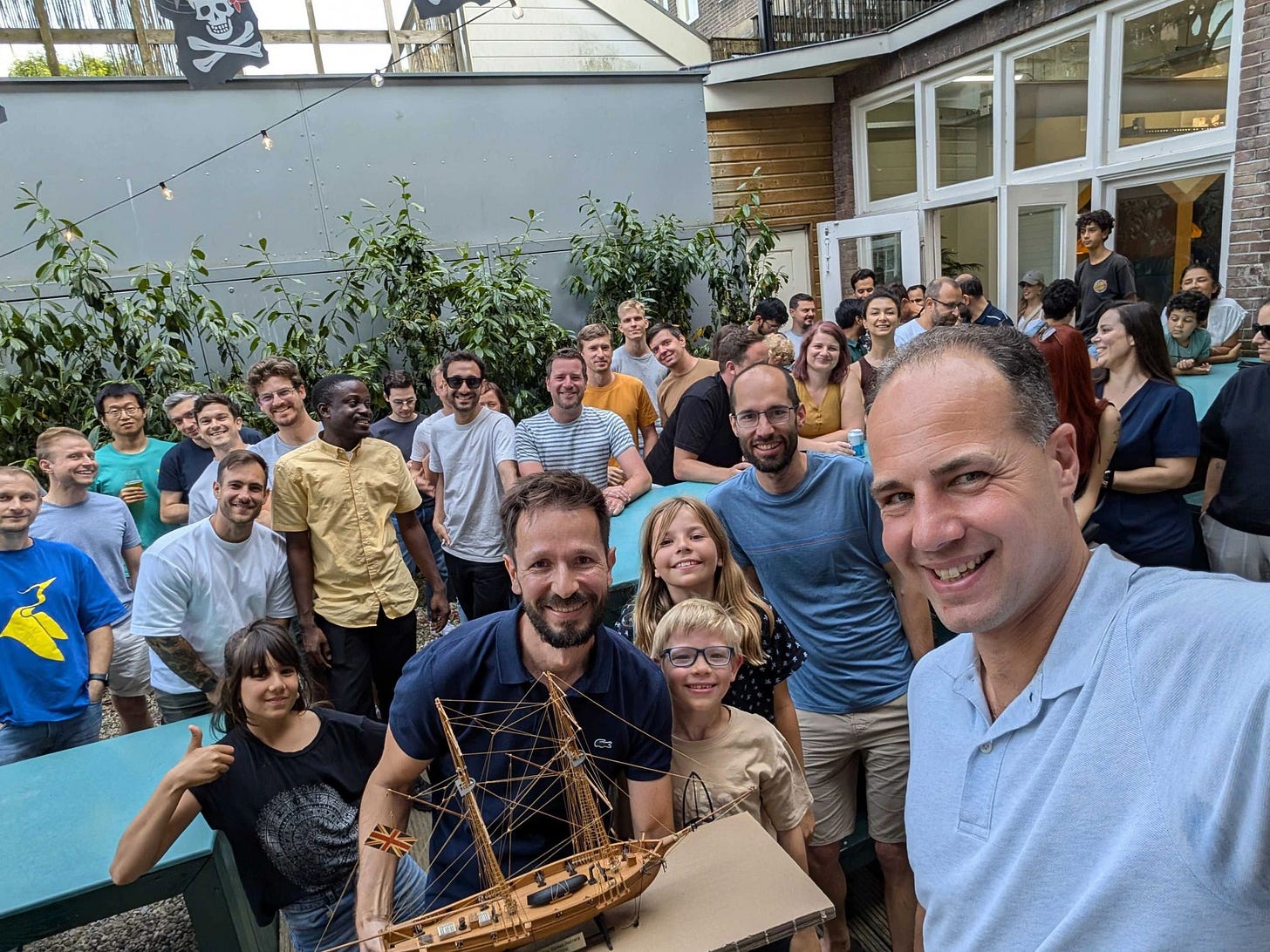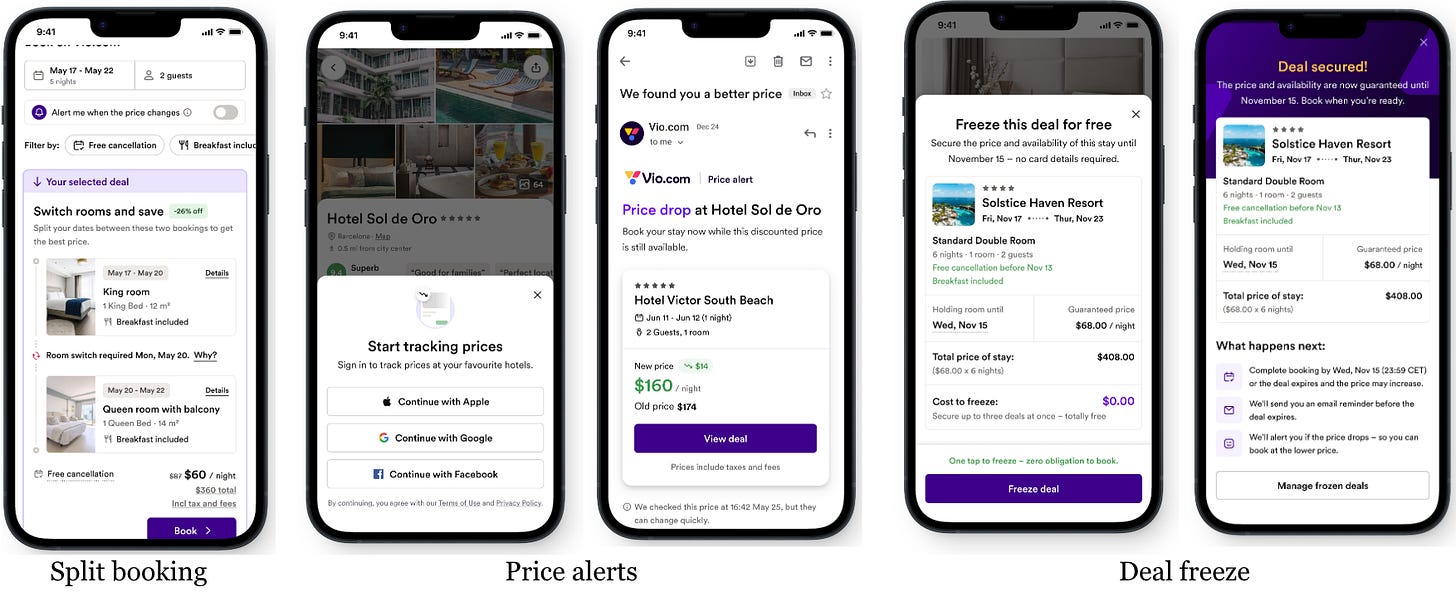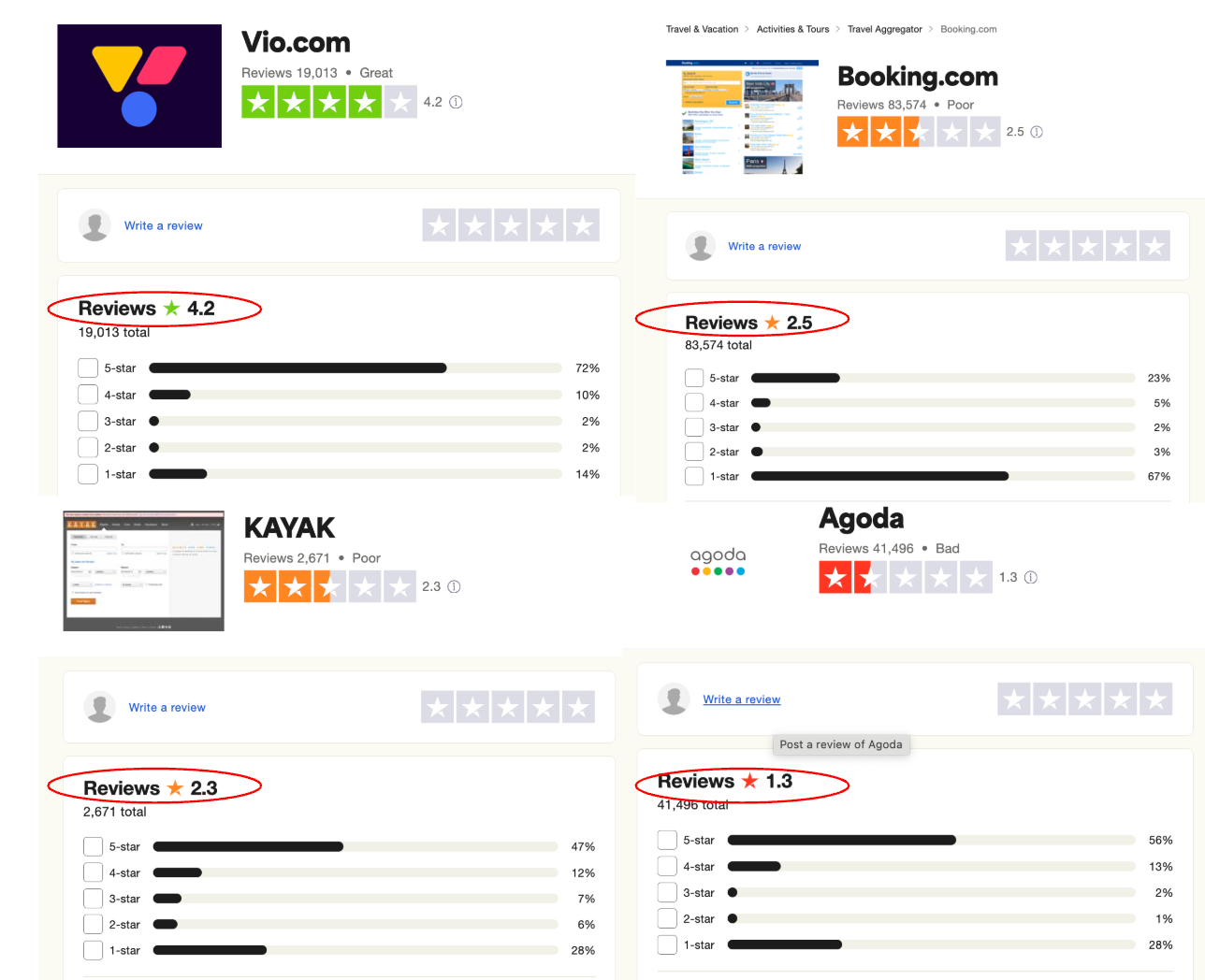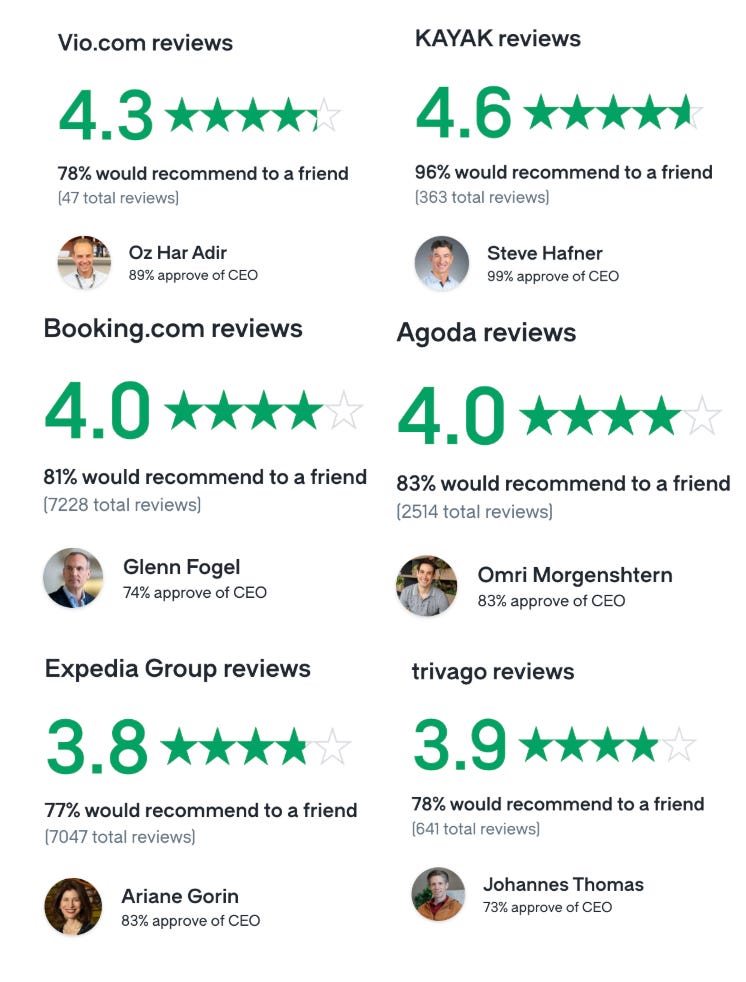Welcome to the third sponsored deep dive on Travel Tech Essentialist. I publish around six of these a year, each one zooming in on a standout company that’s shaping the future of travel. They’re free for all subscribers and meant to go deeper than the usual headlines, with practical insight into strategy, execution, and what’s actually working. If you’re curious how I pick these companies, here’s the thinking behind it.
Today, we’re examining Vio.com, a bootstrapped company that’s quietly built a €1B+ business by solving a fundamental conflict in travel metasearch. I’ve been following Vio.com’s journey for several years, intrigued by its contrarian approach to an industry dominated by venture-backed giants. While most travel companies chase growth at all costs, Vio.com has methodically built a profitable business that puts travelers and transparency first. Their story challenges conventional wisdom about what it takes to succeed in travel tech today.
From a half-empty flight to Venice in 2004 that sparked founder Oz Har Adir’s initial insight to weathering multiple industry crises, Vio.com has continuously evolved its model to align platform economics with customer value. The result is a company that saves travelers money while building a sustainable business, no small feat in an industry notorious for razor-thin margins and winner-take-all dynamics.
Let’s dive in.
The Price Paradox in Travel Meta
Travel metasearch feels like a solved problem. Kayak revolutionized price comparison in 2004. Trivago followed. Google entered the game. Case closed, right?
But there’s a paradox at the heart of travel meta (not unique to metas, though): the cheaper options don’t yield enough revenue, so platforms are incentivized to hide them. This misalignment means travelers often miss the best deals, while metasearch platforms optimize for their own economics rather than user value.
Enter Vio.com, which flipped the script by building a platform that advocates for travelers rather than suppliers. They took a radically different approach by building their product with the mindset of an OTA. By developing a cost-per-acquisition (CPA) auction model rather than CPC, and creating their own booking capabilities, Vio.com aligned their incentives with finding travelers the best deals. This hybrid model preserves meta’s core strength of transparent price comparison while solving its fundamental economic conflict.
The results speak for themselves: Vio.com has grown from €250 million in GMV in 2020 to approximately €1 billion in 2024, a remarkable 4X increase. Looking back further, they’ve achieved 8X growth since 2018, when they recorded around €120 million in GMV. What’s more impressive is that they’ve delivered this consistent expansion while remaining bootstrapped and profitable, competing successfully against some of the most sophisticated customer acquisition machines in the world. Vio.com attributes this success to aligning business incentives with traveler needs. Where some platforms silently compromise traveler interests to maximize their own economics, Vio.com wants to show that a platform that genuinely works for travelers can thrive even against industry giants.
Currently, North America accounts for about half of Vio.com’s business, but that’s changing rapidly. The company is making focused investments in Europe and Middle East & Africa markets, which are set to become the majority of their business by 2026. This strategic shift reflects Vio.com’s ambition to challenge established players in these regions and their confidence in the universal appeal of their approach.
The Venice Flight that Changed Everything
The spark for Vio.com came in 2004, when founder Oz Har Adir took a flight from Venice to Amsterdam. The flight was half full and half the price of what he found on Expedia, which he thought had all available inventory. This experience revealed a crucial gap: existing platforms weren’t surfacing the best deals.
“That trip got me to realize there are interesting distribution problems in travel,” Oz told me. “I needed to learn what existing market solutions don’t solve for in order to build a good solution.”
That moment of clarity led Oz down a winding path of travel tech experimentation. Originally from Haifa, Israel, Oz moved to the Netherlands after his military service to study international business administration at Erasmus University in Rotterdam, followed by a Masters in Strategic Management with an exchange at UC Davis, California. His entrepreneurial journey started early—at 16, he was already building custom websites for small businesses, though as he recalls, “in 1998 small businesses did not even know they needed websites so it was a tough sell.”
By 2004, he tried building a low-cost booking engine but got stuck midway after realizing his initial development budget and timelines were “grossly underestimated.” In 2007, he attempted to create an “organic metasearch” that could beat paid-only solutions like Kayak, but found there was not a very developed angel fundraising community in the Netherlands in 2008, and he gave up.
By 2009, he built a side project called “Ibidlow” that helped users navigate opaque channels like Priceline and Hotwire. The crucial next step came with the founding of FindHotel, which started as a metasearch across multiple travel verticals. The team discovered profitable ways to scale through performance marketing and gradually narrowed their focus to the accommodation space, where they saw the greatest opportunity.
Only after establishing this foundation did the team make their most significant breakthrough: realizing that the fundamental conflict in metasearch couldn’t be solved without controlling the full booking experience. While some other meta players insisted on staying neutral aggregators, FindHotel (later rebranded to Vio.com) made the controversial decision to build its own OTA capabilities to enable better deals with higher-quality experiences and reliability.
“Building a fully capable OTA in-house has long been something meta companies insisted not doing, deeming it too operational and too competitive with their redirect partners,” Oz explained. “Having run on other platforms in the past, we knew that a successful OTA had to be part of the solution.”
This was a massive undertaking. It took Vio.com four years to make their OTA a viable standalone unit. At the beginning of the fourth year, they issued a “now or never” direction to the OTA leadership team, who broke through with “exceptional execution that defied expectations.” The result was a fundamentally different approach to meta, one that aligned platform economics with consumer value.
The company rebranded from FindHotel to Vio.com in November 2022, acquiring the three-letter domain (which means “to travel” in Latin) for a high six-figure sum. The move away from the generic FindHotel name was a strategic decision to create a more differentiated positioning in the market. The rebrand did more than just change the company’s name; it inspired the team to develop original UX and product features that better reflected their distinct approach to travel search.
How Vio.com Saves Travelers Up To 45%
Vio.com’s hybrid model achieves savings of up to 45% for travelers through five key mechanisms that traditional metas and OTAs can’t or won’t implement:
Unbiased price comparison: Unlike most booking sites, Vio.com currently doesn’t let hotels pay for better placement in search results. Their algorithms recommend properties based on what’s best for the customer rather than which hotels pay the highest commissions. This transparent approach means users don’t encounter the common disclaimer about “commission payments affecting property rankings” found on competitor sites. While the company may evolve this approach as it works more closely with hotels in the future, its fundamental commitment to transparency remains a core differentiator.
Universal loyalty access: Vio.com’s loyalty program is a game-changer for casual travelers. While traditional loyalty programs require many bookings or hotel stays to unlock benefits, Vio.com ingeniously maps its own program to supplier tiers behind the scenes. This means even occasional travelers can immediately access exclusive deals that would normally require elite status across multiple chains or OTAs. As German (Vio.com’s CTO) puts it, “By joining Vio.com’s program, you automatically get access to exclusive deals that would otherwise require staying many nights at specific hotel chains.”
Split booking technology: Perhaps Vio.com’s most innovative feature is their split booking capability. The system intelligently divides longer stays across multiple rooms to uncover dramatic savings, sometimes in the hundreds of dollars, with minimal inconvenience. The technology searches across multiple suppliers to create optimal availability—arguably the most critical “commodity” in the accommodation space. Travelers typically only need to change rooms once during their stay, and Vio.com handles all the complexity of finding these optimized combinations. The company is also working on refinements that would allow guests to enjoy these savings without needing to change rooms at all, further enhancing the experience.
Continuous price tracking: Hotel prices fluctuate constantly, making it nearly impossible for travelers to manually track the best time to book. Vio.com solves this by monitoring hundreds of thousands of itineraries every few minutes across all suppliers, effectively automating what would take a traveler countless hours of refreshing dozens of websites. When significant price changes occur, Vio.com immediately notifies customers, helping them capitalize on drops or avoid increases.
Risk-free price freezing (Deal Freeze): Smart travelers know booking early often secures the best rates, but may hesitate to commit weeks in advance. Vio.com’s Deal Freeze feature eliminates this dilemma by allowing travelers to lock in competitive rates without payment details or commitment. The system automatically tracks free cancellation windows and notifies customers when action is needed, making the entire process seamless and risk-free. With just one click, customers can book a free cancellation offer without payment details, and they’re notified when the free cancellation window is about to expire. Deal Freeze is essentially an automated version of what savvy travelers try to do manually, but without the headache of tracking cancellation dates.
The impact is clear in Vio.com’s TrustPilot rating: 4.2 out of 5 based on over 19,000 reviews, significantly outperforming many competitors. This social proof is one of Vio.com’s most defensible advantages: their customers are demonstrably happier than those of competitors.
The Competitive Landscape
Vio.com operates in a market dominated by three types of players: traditional metas (Kayak, Trivago), large OTAs (Booking, Expedia), and Google’s travel products. Each faces the same fundamental conflict: cheaper options don’t yield enough revenue, so there is some incentive to hide them.
To understand Vio.com’s positioning, it’s helpful to consider how different business models in the travel space each have their own strengths and trade-offs:
-
Metasearch platforms (Kayak, Trivago, Google Flights): Excel at aggregating options and providing comparison shopping, but their primarily CPC model can sometimes prioritize clicks over conversion value.
-
OTAs (Booking.com, Expedia, Agoda): These companies deliver seamless booking experiences and strong customer service, though their business models typically emphasize supplier relationships and may not always offer the absolute lowest prices.
-
Alternative accommodation platforms like Airbnb: Have revolutionized the lodging industry with unique stays, but their focus isn’t on traditional hotel inventory or price optimization across multiple suppliers.
-
Vio.com: Unique hybrid model combines elements of metasearch transparency and OTA booking control, with a business design that specifically aligns platform incentives with finding travelers better deals.
This distinctive approach positions Vio.com as an innovator in travel booking—a platform that brings a fresh perspective to how travelers can discover and secure accommodations.
Despite competing in a crowded field, Vio.com’s leadership is clear about their primary competition. “There is one competitor that matters globally and that is Booking.com,” Oz explains. “In EMEA we work on making Vio.com the alternative to Booking in the region.”
Vio.com’s approach differs in three key ways:
CPA-driven auction model: Unlike traditional metas that use cost-per-click (CPC) bidding systems requiring constant management, Vio.com operates on a cost-per-acquisition (CPA) model. This fundamental difference means suppliers don’t need to adjust bids continuously; they only pay when an actual booking occurs. This creates better alignment throughout the entire conversion funnel rather than optimizing merely for clicks.
Customer-first deal optimization: Vio.com prioritizes delivering the best possible deals to travelers through multiple approaches, not just pricing algorithms. Their systems are designed to align customer and platform incentives; when travelers find better deals, Vio.com benefits too. This win-win approach encompasses price feed management, customer segmentation, and sophisticated matching of supply to individual traveler needs based on behavior and location.
Product flexibility: The team can rapidly experiment with features at every step of the booking funnel, measuring impact on conversion rates in real-time.
Building Defensible Advantages
Some of Vio.com’s most important competitive moats include:
Supplier relationships. The company has built deep partnerships with dozens of suppliers (set to cross the 50-mark in 2025), creating both natural price competition and high levels of trust. Years of experience have established Vio.com as a reliable partner that major industry players work with effectively and trust with their best supply and data. The consumption-based model, rather than advertising, encourages partners to share valuable booking data they typically guard closely.
Profitable customer acquisition expertise. The team has refined its performance marketing approach over years of bootstrapped operation, developing sophisticated capabilities to acquire customers at positive ROI from day one. Without venture funding to subsidize growth, they’ve built proprietary systems that identify high-value acquisition opportunities across channels that larger competitors often overlook or can’t operate profitably.
Their ability to consistently deliver superior deals. Combining diverse supplier relationships, technical infrastructure, and algorithmic optimization enables Vio.com to find savings that other platforms miss. This deal-finding capability creates a fundamental value proposition that drives both initial customer acquisition and long-term loyalty.
Technical expertise in wholesale supply management. The team has developed specialized knowledge in navigating the fragmented wholesale hotel market, where no single global solution exists. Determining which partners to work with and how to enforce consumer-grade service level agreements has required years of investment and learning through trial and error.
Expansion through affiliates. Vio.com recognizes the market reality that travelers often search multiple platforms before making booking decisions, which has led to a promising growth opportunity: their affiliate program. By enabling travel sites to integrate Vio.com’s price comparison tools directly into their own platforms, they’ve created a system where everyone benefits: partners boost their monetization without losing visitors, travelers get better deals, and Vio.com extends its reach. This approach has proven especially valuable for OTA partners who value incorporating comparison tools into their offering while keeping their direct customer relationships. Launched in 2023, Vio.com’s affiliate program is becoming a key growth driver for Vio.com and its affiliates.
Localization investments that larger competitors haven’t matched. Features like adding native language support create conversion advantages as high as 5-10X in certain markets, a bar that “only 2-3 competitors meet better than us across these markets today,” according to Oz.
Customer service excellence. Compared to competitors, Vio.com invests more in personalized customer support. This commitment is evident in their TrustPilot reviews, which frequently highlight the company’s exceptional support during difficult situations.
Social proof. Perhaps most importantly, their customers are happier than those of competitors, as demonstrated by their TrustPilot ratings and customer feedback.
The result is a virtuous cycle: returning visitors convert at several times the rate of new visitors because they access better prices, and partners often offer Vio.com users special rates they don’t make available elsewhere due to the competitive environment Vio.com has created.
The Bootstrap Way: Growth Without Venture Capital
Bootstrapped isn’t just a financing choice for Vio.com, it’s core to its DNA. Without the luxury of burning cash to acquire customers, the company had to build sustainable unit economics from day one.
“Given that travel distribution is a mature industry, our main KPI is contribution margin,” Oz notes. “Revenue growth is often correlated with it but only in rare occasions do we focus on revenue growth specifically because reaching it without positive ROI is rather useless.”
This discipline shows up in their marketing approach. For years, the company maintained strict financial discipline by focusing on immediate positive ROI. This created a foundation of sustainable growth rather than the boom-and-bust cycles common among venture-backed competitors.
Over time, Vio.com has evolved its approach as the product and mobile apps matured. These improvements allowed the team to shift from immediate ROI targets toward more sophisticated lifetime value models. This evolution opened up new marketing channels and internal strategies like web-to-app conversion paths, all while maintaining the company’s bootstrap discipline.
The bootstrap approach offers another major advantage that would prove crucial throughout Vio.com’s journey: resilience during crises.
Thriving Through Crisis: The Vio.com Way
Vio.com has developed a remarkable ability to navigate industry turbulence. As Oz has observed, “across the lifetime of the company we would face a crisis about every 18 months, a rule that still holds today.” This recurring pattern has transformed crisis management from a survival skill into a core competency.
When COVID hit in early 2020, Vio.com saw a 90% revenue decline virtually overnight. The company could have crumbled. Instead, they took a methodical approach, detailed by Oz in a May 2020 blog post.
Leveraging macro goodwill: The team secured flexibility from partners like Google and Microsoft while accessing government support in the Netherlands, buying crucial breathing room when cash flow concerns were most acute.
Transparent communication: Oz launched a daily internal blog that shared the company’s financial situation and response initiatives. This radical transparency, including company-wide cashflow projections, built unprecedented trust among team members during the darkest days.
Extreme focus: The company shifted to extreme focus mode, becoming a “cancellation first” product when that became travelers’ primary concern. They optimized every aspect of their platform to address what had suddenly become the market’s most pressing need.
Data-driven opportunity hunting: Vio.com created a “data war room” to identify resilient market segments. This analysis revealed opportunities even within the devastated travel landscape, allowing specialized teams to launch targeted initiatives that doubled their scale within just four weeks.
Offensive expansion: Rather than retreating, they accelerated their partnership program, recognizing their consumption-based model was more resilient than ad-driven alternatives. This offensive stance became a signature Vio.com move they would deploy again when facing future challenges.
Similar resilience was demonstrated when Google’s core update recently impacted traffic. Each time, the company emerged stronger. Any of these could have killed the company. Instead, each crisis became an opportunity to get stronger. The COVID crisis led to innovative new products. The traffic drop sparked better conversion optimization.
The AI Agent Elephant in the Room
While many predict AI agents will bypass traditional travel players, Vio.com sees a different future. The company believes AI agents will create a new ecosystem layer rather than replace existing infrastructure, a view shared by 68% of travel industry professionals in a recent Travel Tech Essentialist survey.
“The openness that ‘meta’ brings is here to stay even in the age of AI,” Oz notes. “It’s impossible to build one product that captures all the value in the market if you are not willing to partner and often ‘link out’.”
This points to an emerging bifurcation in travel tech: one layer optimized for AI agents to efficiently process and book travel, another focused on human experience and discovery. Vio.com’s hybrid model and API-first architecture positions them to serve both.
The company has built API capabilities that are both straightforward and powerful, delivering access to deals at massive scale with near-instant response times. Their APIs are engineered to identify properties recommended by large language models accurately, but the functionality extends beyond LLMs; any OTA can leverage these APIs to integrate comparison features into their offerings.
Interestingly, Vio.com takes a pragmatic view on AI’s future impact. They expect AI to improve the travel shopping process and handle certain tasks, but believe the customer’s selection will remain critical for non-commodity products like accommodations. In their vision, we’ll see expanded search capabilities, fluent UIs generated on the fly, task-oriented AI agents that track price changes, instant customer service, and personalized recommendations, but the final booking decision will likely remain with the human traveler.
Rather than racing to be an AI innovator for its own sake, Vio.com is taking a measured “wait-and-see” approach. They’re building capabilities across their systems and operations while remaining focused on solving real customer problems. They believe that AI agents will eventually become sophisticated enough to work with standard APIs, so their technical investments focus on the application layer where they can make travel shopping more useful and effective for users.
This practical approach aligns with Vio.com’s broader strategy: focusing on fundamental user needs first, then applying technology where it genuinely adds value. In the emerging AI landscape, this positions them to evolve alongside customer expectations rather than chasing technological novelty for its own sake.
The People Behind the Platform
Vio.com’s culture and team are essential to understanding its success. “The hardest thing about building a company to scale is how long it takes,” Oz reflects. His determination through multiple failed attempts shows the persistence that’s become embedded in company culture.
Today, Oz lives near Amsterdam with his wife Janneke and their four children. When he’s not building Vio.com, he’s an avid football fan and amateur goalkeeper—a fitting role for someone whose company has repeatedly defended against existential threats.
One leadership insight stands out: shifting from crisis management based on “trust me” to radical transparency. “The main change was to move the crisis modus from ‘trust me’ while keeping all the details to myself, to being exceedingly open, down to sharing companywide our cashflow situation and the risks involved,” Oz explains.
This approach was tested during COVID-19. While many travel companies conducted large-scale layoffs, Vio.com maintained its entire staff. “We never had to lay off a single person for a financial reason then and that remained true since we started the company,” Oz proudly notes.
The result is a team that sticks around. “In late 2017 we had a major crisis with ⅓ of the company leaving in the aftermath as they lost trust that I knew where to go. We recovered in early 2018 and those who survived the crisis are largely still here, as did almost all the great people who joined us since.”
This commitment to transparency and team-building is reflected in the company’s internal survey results. In an anonymous survey of 30 employees that I conducted, 73.3% of respondents strongly agreed that they’re proud to tell others they work at Vio.com, while 20% agreed. Also as impressive, 56.7% strongly agreed that the company’s values align with their personal values, with the remaining 43.3% agreeing.
When asked about leadership transparency, 76.7% strongly agreed that leadership is transparent about company challenges and opportunities. Similarly, 73.3% strongly agreed that Oz’s leadership style positively influences company culture.
The words employees use to describe Vio.com’s culture reveal a lot about the company: “transparent,” “energetic,” “ambitious,” and “innovative” appear frequently, alongside more surprising terms like “caring,” “humanitarian,” and “nurturing.” As one employee put it, Vio.com is “demanding, caring, open”, a combination that speaks to the company’s dual focus on high performance and human connection.
When asked about their favorite aspect of working at Vio.com employees consistently mentioned flexibility, transparency, and the opportunity to work with brilliant colleagues. One employee wrote, “Employees are treated as people, not only numbers that are replaceable.” Another valued “The freedom to operate – everyone acts like their own ‘mini CEO’ to get shit done.”
The bootstrap approach has fostered a pragmatic, results-oriented culture. As one employee explained, “Working with constraints leads to more creativity and avoids waste & bloat.” Another noted, “It forces me to think about customers all the time and to be pragmatic; no space for BS.”
Perhaps most tellingly, when asked what impressed them about Oz’s leadership, employees cited his hands-on approach and genuine care for people. One response particularly stood out: “Being hands-on and always around, is inspiring and brings a lot of motivation to the day to day. I love working for a company where the founder is still fully invested in the mission of the company 10+ years later. I know that everything we are doing is so that we eventually MAKE IT.” This sentiment—of a founder still deeply committed to the mission a decade in—was echoed by another employee who wrote: “He knows everybody from the company by name, he cares about his employees and wants them to grow and have fun.” Another mentioned, “While rough around the edges – he is honest and transparent about what is happening, and has a strong leadership direction to push us through.”
It’s clear from these responses that Vio.com’s success isn’t just a product of smart strategy and technological innovation; it’s also built on a foundation of trust, transparency, and mutual respect between leadership and employees.
Vio.com’s commitment to transparency is also validated by external measurements as well. Glassdoor data shows Vio.com earning a strong 4.3/5 rating, with 78% of employees recommending the company to friends. Most notably, Oz’s CEO approval rating stands at an impressive 89%.
These numbers compare favorably against the industry’s heavyweights. Vio.com’s 4.3 rating outperforms Booking.com (4.0), Agoda (4.0), Expedia Group (3.8), and Trivago (3.9); all companies with vastly greater resources and established HR operations. While Kayak leads the pack with a 4.6 rating and 96% recommendation rate, Vio.com’s ability to maintain employee satisfaction that rivals or exceeds most billion-dollar competitors speaks volumes about their culture.
This external validation confirms what employees expressed in our survey: Vio.com has built something special. For a bootstrapped company competing against industry giants, maintaining such high employee satisfaction isn’t just a nice-to-have, it’s a strategic advantage that enables them to attract and retain talent that might otherwise be drawn to more established names. It also creates a virtuous cycle where engaged employees deliver better customer experiences, reinforcing Vio.com’s competitive position in the market.
Challenges & Opportunities
While Vio.com has built impressive momentum, several key challenges remain:
Challenges:
-
Building brand recognition in a crowded space dominated by well-funded incumbents
-
Maintaining deal quality while scaling rapidly
-
Competing with both traditional players and new AI-powered entrants
-
Managing the complexity of being both a meta platform and OTA
Opportunities:
-
International expansion beyond current core markets
-
Deeper integration with emerging AI travel planning tools
-
Building out additional verticals beyond accommodation
-
Leveraging their API-first architecture to become infrastructure for next-gen travel companies
Vio.com’s top strategic priority is clear: “It’s less about ‘international expansion’ and more around cracking European markets that were dominated by Booking specifically,” Oz explains. “There is no alternative to Booking in Europe right now and we want to be it.“
Beyond direct consumer business, the company also sees substantial potential in powering better accommodation offerings across the industry. They believe many travel products currently either display low-quality inventory, show only expensive options, or simply refer users to Booking.com. Vio.com’s infrastructure could help raise the standard throughout the ecosystem.
Looking Ahead
Vio.com’s journey offers a glimpse into how travel search might evolve. While others see existential threats from AI agents and industry consolidation, Vio.com sees opportunity in the chaos. Their vision of putting more power in travelers’ hands has proven resilient through multiple industry shifts, and their bootstrap-driven focus on fundamentals has built something rare: a rapidly growing business that’s both innovative and profitable while remaining true to its traveler-first principles.
Rather than diversifying beyond their core offering, Vio.com is doubling down on accommodation, with a laser focus on traditional hotels that account for 95% of their current business. The team sees massive untapped potential in their current market, believing they can grow 20X within hotels organically without expanding to new verticals. This strategic concentration allows them to deepen their competitive advantage rather than diluting efforts across multiple verticals or even alternative accommodations, which currently make up just 5% of their business.
The numbers tell the story: €1B+ in annual bookings, with 25% through their own OTA. A 40% compound annual growth rate over five years. Thirty active affiliate partners ranging from established players like Skyscanner and HolidayPirates to emerging AI startups.
Vio.com aims to continue growing organically and double the business through 2026 (40% compound annual growth in 2025/2026) with expansion primarily through increased investment in branded marketing & via the affiliate program.
Their affiliate program, now in its second year, represents a key growth vector. The adoption of Vio.com’s hybrid model across the industry is fundamental to meeting their ambitious targets. While the hybrid OTA/meta approach isn’t yet standard practice, particularly among flight OTAs, Vio.com believes this will change. If their prediction proves correct, it would unlock significant new growth opportunities beyond their direct consumer business.
Success will be measured both by growth and by customer loyalty. As Oz notes, “In the past 3 years, we saw our retention rates (revenues from direct returning bookings) grow 5X. They can’t continue at that pace but we should see them grow further and into the level of industry leaders.”
The future of travel search may look very different than today. But Vio.com’s bootstrap-driven focus on fundamentals, relentless customer advocacy, and willingness to challenge industry orthodoxy positions them well to help shape whatever comes next.
By consistently prioritizing traveler empowerment over short-term gains, Vio.com has built a model that challenges fundamental industry assumptions about who travel platforms should serve. This ‘Power to the Traveler’ ethos may well prove to be their most enduring innovation. Travel booking shouldn’t feel like a game travelers are set up to lose. Vio.com is changing that by putting power back in the hands of travelers, where it belongs.
If you’d like to explore partnering with Vio.com, you can contact them here.
This is the third sponsored deep dive on Travel Tech Essentialist. I write these pieces to highlight innovative companies shaping the future of travel, with full editorial independence. If you’re a travel company interested in being featured in a future sponsored deep dive, please visit my deep dive philosophy page to understand my selection criteria and reach out through the contact link there.











